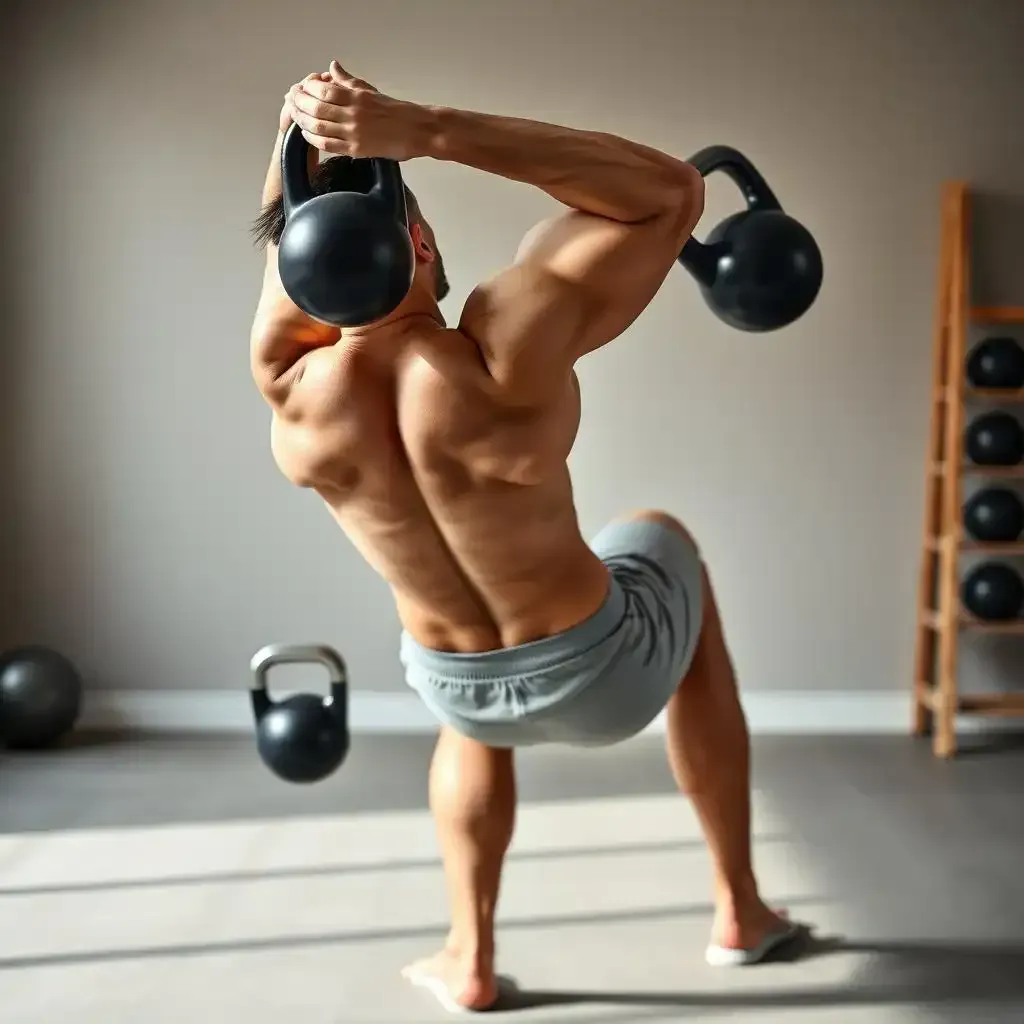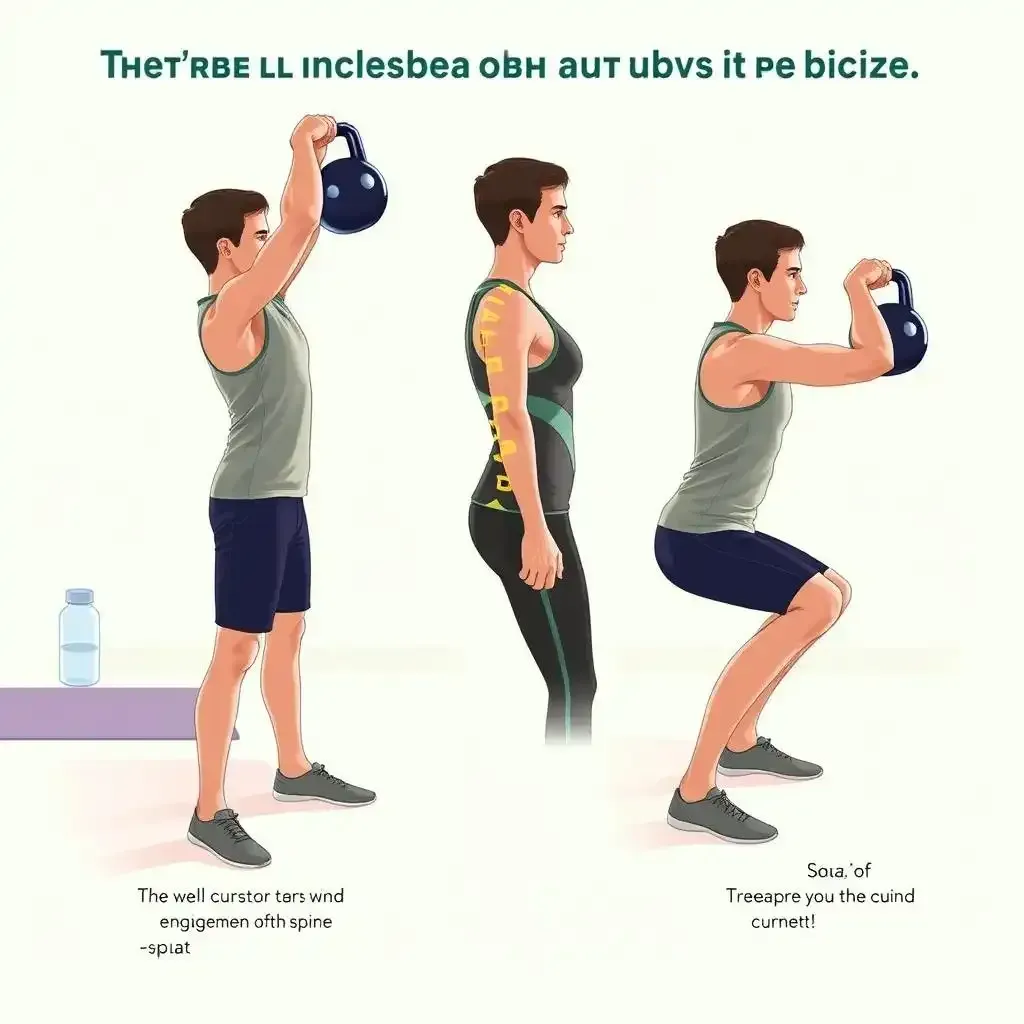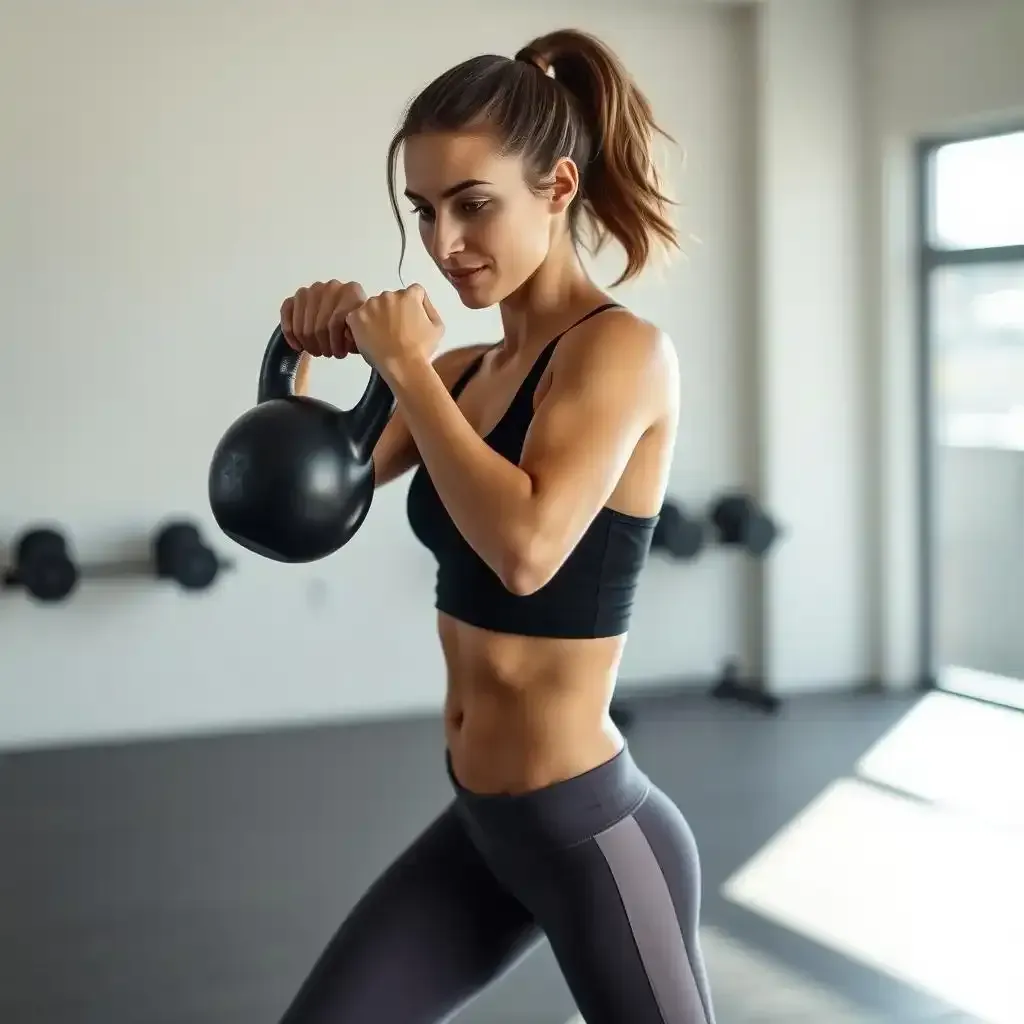Table of Contents
Are you tired of slumping? Does your back ache after a long day? Many people struggle with poor posture, leading to discomfort and even long-term health problems. But what if I told you there's a fun and effective way to strengthen your core, improve your back, and stand taller? Enter the amazing world of kettlebells! kettlebell exercises for posture offer a dynamic and engaging approach to improving your body alignment and overall well-being. This article, brought to you by kettlebellworkout.homes, will guide you through a series of exercises, explaining the benefits of each and emphasizing the importance of proper form. We'll start with some beginner-friendly moves and gradually progress to more challenging exercises as you build strength and confidence. Get ready to learn how kettlebells can help you achieve a straighter, stronger, and healthier you! Remember, consistency is key. Even a few minutes of kettlebell training each day can make a noticeable difference in your posture over time. So, let's begin on this trip to better posture together!
Kettlebell Exercises for Posture: A Beginner's Guide
Getting Started: Your First Kettlebell Workout
Hey there, future posture pro! Let's be honest, kettlebells can look a little intimidating at first. They're like those cool older kids at school – you want to hang out with them, but you're not sure how to approach them. Don't worry, I've got your back (and your posture!). We're going to start slow and steady, building a strong foundation before we tackle anything too crazy. Think of it like learning to ride a bike – you wouldn't jump on a downhill mountain bike on your first try, would you? We'll start with some basic moves that will help you get comfortable with the kettlebell and build the muscle strength you need for better posture. Remember, consistency is key! Even 10 minutes a day can make a big difference.
Before you even think about swinging that kettlebell, let's talk about choosing the right one. Too heavy, and you'll hurt yourself. Too light, and you won't get the benefit. A good rule of thumb is to start with a weight you can comfortably lift for 10-12 repetitions. If you're completely new to kettlebells, you might want to start with a lighter weight, like 8kg or 12kg. Don't be afraid to ask for help at your gym or check out a beginner's guide – kettlebell basics here! Once you've found your perfect kettlebell, we're ready to rock!
Exercise | Reps | Sets |
|---|---|---|
Goblet Squat | 10-12 | 3 |
Kettlebell Swing (light weight) | 15-20 | 3 |
One-Arm Row (light weight) | 10-12 (each arm) | 3 |
Building a Strong Foundation: Posture-Perfect Exercises
Now that you're feeling comfortable with the kettlebell, let's move on to some exercises that directly target the muscles responsible for good posture. Think of your posture as a house – you need a strong foundation (core muscles) and sturdy walls (back muscles) to keep everything upright. These exercises will help you build that foundation and those walls, leading to improved posture and a more confident stance. Don't forget to breathe! Deep breaths help keep your core engaged and your posture stable.
One of my favorite exercises for posture is the kettlebell halo. It's a simple yet effective exercise that strengthens your rotator cuff muscles, which are crucial for shoulder stability. Another great exercise is the renegade row, which works your entire core as well as your back muscles. Imagine your core is a superhero cape – it supports your whole body. For a full body workout that builds strength and improves posture, check out these beginner kettlebell routines. Remember, proper form is key here – it's better to do fewer repetitions with perfect form than many repetitions with sloppy form. So focus on quality over quantity!
- Goblet Squat
- Kettlebell Swing
- Renegade Row
- Kettlebell Halo
Kettlebell Exercises for Posture: Targeting Specific Muscle Groups

Kettlebell Exercises For Posture Targeting Specific Muscle Groups
Okay, so we've got the basics down – you're comfortable with a kettlebell, you're not afraid to swing it (carefully!), and you're ready to level up your posture game. Now it's time to get really specific. Think of your body like a team – you've got your star players (the big muscles like your glutes and lats), your reliable bench players (your core muscles), and your unsung heroes (all those tiny muscles that keep everything stable). To get amazing posture, we need to train them all!
Let's start with the back. A strong back is the backbone (pun intended!) of good posture. Exercises like the one-arm row are brilliant for targeting those back muscles. Imagine your back muscles are like strong ropes holding up a tent – the stronger the ropes, the better the tent stands. For a more advanced move, try the Romanian deadlift – it's like a one-legged dance move, but instead of fancy footwork, it's all about controlled strength and glute activation. And don't forget those glutes! They're not just for squats; strong glutes help keep your pelvis aligned, which is key to maintaining good posture. You can check out our guide on kettlebell exercises for your back for some extra pointers. Kettlebell back exercises are key!
- One-Arm Rows: Build back strength like a superhero!
- Romanian Deadlifts: Work your glutes and hamstrings for pelvic stability.
- Kettlebell Swings: A full-body exercise for improving posture and core strength.
Your core is the powerhouse of your posture. It's the unsung hero holding everything together. Think of it as the central pillar of a magnificent castle – strong and stable. The kettlebell swing, for example, is fantastic for core engagement. It's not just about swinging the weight; it's about engaging your entire core to control the movement. Another exercise that's really effective for core strength is the renegade row – it's like a plank on steroids! For a complete core workout, I recommend checking out our beginner kettlebell routines; they're designed to help you build a rock-solid core. Beginner kettlebell routines for a strong core!
Finally, let's not forget about your shoulders. Strong, stable shoulders are essential for good posture. Exercises like the kettlebell halo are perfect for improving shoulder mobility and stability. It's a slow, controlled movement that works all the muscles surrounding your shoulder joint. It's like giving your shoulders a gentle massage with a weight. Remember, this is about building strength and stability, not just about how much weight you can lift. Focusing on proper form is crucial for injury prevention and maximizing results. For more detailed tips and exercises, you can look at our guide to kettlebell exercises for shoulder stability. Kettlebell shoulder stability exercises are a must!
Muscle Group | Exercises | Why it matters for posture |
|---|---|---|
Back | One-arm rows, Romanian deadlifts | Provides support and stability for your spine. |
Core | Kettlebell swings, Renegade rows | Keeps your spine aligned and prevents slouching. |
Shoulders | Kettlebell halos | Improves shoulder mobility and stability, preventing rounded shoulders. |
Kettlebell Exercises for Posture: Safety and Proper Form

Kettlebell Exercises For Posture Safety And Proper Form
When it comes to working out with kettlebells, safety should always be your top priority. Proper form and technique are essential to getting the most out of your kettlebell exercises while minimizing the risk of injury. This is especially important when it comes to kettlebell exercises for posture, as poor form can actually exacerbate postural problems.
So, what can you do to ensure you're using proper form when doing kettlebell exercises for posture? First, make sure you're standing or sitting up straight with your shoulders relaxed and your core engaged. Keep your kettlebell at a comfortable weight and focus on slow, controlled movements. Avoid jerky or bouncy movements, as these can put unnecessary strain on your muscles and joints.
Exercise | Proper Form | Common Mistakes |
|---|---|---|
Kettlebell Swing | Keep your back straight, engage your core, and swing the kettlebell back between your legs | Letting your back arch or your core relax, swinging the kettlebell too high or too low |
Kettlebell Row | Keep your back straight, engage your core, and lift the kettlebell to your side | Letting your back arch or your core relax, lifting the kettlebell too high or too low |
Kettlebell Goblet Squat | Keep your back straight, engage your core, and lower your body down into a squat | Letting your back arch or your core relax, not lowering your body down far enough |
Remember, proper form and technique are key to getting the most out of your kettlebell exercises for posture. Take your time, focus on slow and controlled movements, and don't be afraid to ask for help or guidance if you need it. With practice and patience, you can master the proper form and technique for kettlebell exercises and start seeing improvements in your posture.
- Read our for more information on proper form and technique.
- Check out our for more exercises and tips to help you improve your posture.
- Practice makes perfect! Start with short workouts and gradually increase your time and intensity as you become more comfortable with the exercises and build your strength and endurance.
Proper form and technique are key to getting the most out of your kettlebell exercises for posture. Take your time, focus on slow and controlled movements, and don't be afraid to ask for help or guidance if you need it.
Stay safe and keep on exercising!
Advanced Kettlebell Exercises for Posture Improvement

Advanced Kettlebell Exercises For Posture Improvement
Taking it Up a Notch: More Challenging Kettlebell Moves
Alright, champ, you've mastered the basics. Your posture's improving, you're feeling stronger, and you're ready for a real challenge. Think of it like this: you've learned to ride a bike, now it's time to tackle some hills! We're going to introduce some more advanced kettlebell exercises that'll really push your limits and sculpt your body into a posture-perfect masterpiece. These exercises require more strength, balance, and coordination, so remember to focus on proper form and start with lighter weights. Don't try to impress anyone – impress yourself by mastering the technique. A slow and steady approach is always better than rushing into something you're not ready for. Remember, safety first! Always prioritize proper form over lifting heavier weights.
One exercise that's a game-changer is the Turkish Get-Up (TGU). This dynamic movement is a full-body exercise that challenges your stability, strength, and coordination. It's like a full-body puzzle, requiring you to work every muscle group to smoothly transition from lying down to standing. Another awesome exercise is the kettlebell snatch – it’s like a powerful dance move that builds explosive capability and improves your posture. But be warned! These exercises require a solid foundation of strength and balance. If you're not comfortable with the basics, it's best to spend more time perfecting those before moving on. For more info on building that foundation, check out our kettlebell exercises starter guide.
- Turkish Get-Up (TGU): A full-body challenge for ultimate posture improvement.
- Kettlebell Snatch: A powerful move that builds explosive strength and improves balance.
- Clean and Press: A classic kettlebell exercise to build upper body strength.
Mastering the Movement: Tips for Advanced Kettlebell Exercises
So you’re ready to take on the challenge of more advanced kettlebell exercises? Fantastic! But before you go charging ahead, let’s talk about proper form and technique. Remember, these moves require more precision and control than the beginner exercises. Think of it like learning to play the piano – you wouldn’t expect to play Chopin flawlessly after just a few lessons, right? It takes time, patience, and practice to perfect these advanced moves. Start slow, focus on each movement, and don't be afraid to use lighter weights if you need to. Remember, quality over quantity is the motto here – better to do fewer reps with perfect form than many reps with sloppy form. Your body will thank you for it!
One common mistake beginners make with advanced kettlebell exercises is trying to lift too much weight too soon. This can lead to injury and frustration. Start with a weight you can comfortably handle for 8-10 repetitions with perfect form. As you get stronger, you can gradually increase the weight. Another important tip is to focus on your breathing. Proper breathing helps to engage your core muscles and stabilize your body. Exhale during the exertion phase of the exercise (like lifting the weight) and inhale during the recovery phase (like lowering the weight). This helps to maintain proper posture and prevent injury. And remember, if you're ever unsure about proper form, don’t hesitate to seek guidance from a qualified fitness professional. Check out more tips and routines on our kettlebell workout tips page.
Exercise | Key Considerations | Common Mistakes to Avoid |
|---|---|---|
Turkish Get-Up | Smooth, controlled movements; core engagement; proper breathing | Rushing the movement; arching the back; using momentum |
Kettlebell Snatch | Explosive hip extension; full body extension; controlled descent | Using only arms; jerky movements; dropping the kettlebell |
Final Thought
Improving your posture with kettlebells is a trip, not a race. Remember to listen to your body, start slowly, and gradually increase the weight and intensity of your workouts. Consistency is crucial. By incorporating these kettlebell exercises into your routine and focusing on proper form, you'll not only improve your posture but also build strength, increase flexibility, and boost your overall fitness level. So, grab your kettlebell, and let’s work towards a stronger, more confident you. Don't forget to check out more amazing kettlebell workouts and tips on kettlebellworkout.homes!